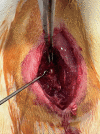Is Tranexamic Acid an Effective Prevention in the Formation of Epidural Fibrosis? Histological Evaluation in the Rats
- PMID: 37334444
- PMCID: PMC10483163
- DOI: 10.3340/jkns.2022.0249
Is Tranexamic Acid an Effective Prevention in the Formation of Epidural Fibrosis? Histological Evaluation in the Rats
Abstract
Objective: The present study aimed to determine the topical and systemic efficacy of tranexamic acid (TXA) on epidural fibrosis in a rat laminectomy model.
Methods: Thirty-two 12-month-old adult Sprague-Dawley rats were used in this study. Each rat underwent bilateral laminectomy at the L1 and L2 vertebral levels. Rats were divided into four groups : in group I (control group, n=8), a laminectomy was performed and saline solution was applied into the surgical space. In group II (topical group, n=8), laminectomy was performed and 30 mg/ kg TXA was applied to the surgical site before skin closure. In group III (systemic group, n=8), 30 mg/kg TXA was administered intravenously via the tail vein in the same session as the surgical procedure. In group IV (topical and systemic group, n=8), TXA was administered 30 mg/kg both topical and intravenous. The rats were sacrificed at 4 weeks postoperatively. Masson's trichrome and hematoxylin and eosin were used to assess acute inflammatory cells, chronic inflammatory cells, vascular proliferation, and epidural fibrosis.
Results: Epidural fibrosis, acute inflammation, chronic inflammation, and sum histologic score value were significantly lower in the systemic TXA group, systemic and topical TXA groups than in the control group (p<0.05). In addion, the sum histologic score was significantly lower in the topical TXA group than in the control group (p<0.05).
Conclusion: In this study, epidural fibrosis formation was prevented more by systemic application, but the topical application was found to be effective when compared to the control group. As a result, we recommend the systemic and topical use of TXA to prevent epidural fibrosis during spinal surgery.
Keywords: Epidural fibrosis; Laminectomy; Rats; Tranexamic acid.
Conflict of interest statement
No potential conflict of interest relevant to this article was reported.
Figures



References
-
- Burton CV, Kirkaldy-Willis WH, Yong-Hing K, Heithoff KB. Causes of failure of surgery on the lumbar spine. Clin Orthop Relat Res. 1981;(157):191–199. - PubMed
-
- Çirci E, Özalay M, Caylak B, Bacanli D, Derincek A, Tuncay IC. The effect of oophorectomy on epidural fibrosis after laminectomy: an experimental study in rats. Acta Orthop Traumatol Turc. 2013;47:193–200. - PubMed
-
- Cravens GT, Brown MJ, Brown DR, Wass CT. Antifibrinolytic therapy use to mitigate blood loss during staged complex major spine surgery: postoperative visual color changes after tranexamic acid administration. Anesthesiology. 2006;105:1274–1276. - PubMed
LinkOut - more resources
Full Text Sources
Research Materials

